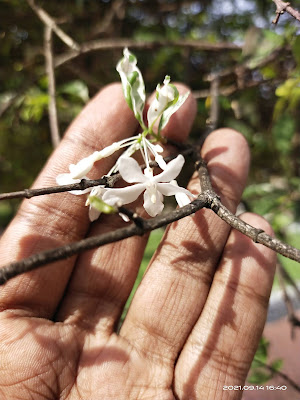
INTRODUCTION:
I'm actually surprised to find that Gardenia do not have a separate botanic name rather it is simply referred to it's common name Gardenia however there are around 140 subspecies which may have been identified based location found all around the world, native to tropical and subtropical regions especially around Asia, Australia parts of Africa and surrounding regions.
There are deep cultural history and traditions that came a long way with Gardenia - mainly around Europe and also in Asia - in some regions it is also used as medicinal apart from the aromatic uses.
The Fragrance - I would describe is very much similar like Grand Duke of Tuscany mix with Plumeria, almost similar like sweet notes, I must say, I can really tell the difference as they are truly mesmerising like evening flowers. However, it has a slight woody notes in comparison to Jasmine.
Another factor to note on a caution is that I often find minute insects making its home on the flower, hence before taking a whiff in smelling the fragrance - to inspect carefully as you don't want to take in these insects together in your nasal glands.

PLANT CHARACTERISTICS:
Gardenia is actually a genus from a coffee plant family however it does not bear any seedpod like a coffee plant nor it is a jasmine family, though it is unique - it's similarities are like most Jasmines and Fragrant Flowers - this particular flower only last a day, these bloom from evening to morning and the flowers last a day in these hot tropical climate. Elsewhere it is different in temperate climate zone where these blooms can last for days to weeks during summer.
However, I'm focusing these plant characteristics based on my climate zone - hence these details are based on my climate conditions.
These flowers have a wavy petals and emits a nice cool fragrance during evening time and may fully dried off on its stem turning into creamy yellow in color. At times, they may form clustered flowers as new buds appear from the crown producing new blooms in daily basis but this may occur based on the plant variety. These have been cultivated over centuries long hence there are may be considered as heirloom plant considering whether they are in temperate regions or hot and dry climate.
LIGHT:
Being a Tropical plant does require good strong indirect bright sunshine, It can tolerate growing in shaded area however it must receive at least 6 hours of sunshine. It does not do well in heavy shaded area and may not bloom in such conditions. Also the leaves may turn yellow and also become leggy. Another factor in the lack of sunlight may cause the plant to become stress and can attract pest to heavily attack on them.
Hence do give a thought if your are not having open garden area as this would not so well as indoor plant - even placing them as a balcony potted plant can be challenging if they receive inadequate light.

SOIL MEDIUM:
Considering one of the most basic thing about planting material - this one doesn't require anything special - just any balanced potting mix will do. They seem to do fine in a medium or big potted plant - however they will do great if they are planted directly into the garden soil as these will require just that to produce those lovely blooms.
However if limitation occurs where you can only grow in pot - then a good balanced potting mix with rich amount of organic material and equal part of well drained soil which will help from root rot.
Instance as such as these - they are often planted straight into open garden land where they are not in a pot - hence they appear hardy and able to take the heavy pruning.
WATERING & FEEDING:
It may require a good adequate watering - both morning and evening based on the size of the plant.
You can grow it in a nice medium or large size pot, the plant will behave and grow based on the size of the pot. However I would recommend this to grow freely on ground if you want lushful beautiful constant blooms.
Also this plant is a heavy feeder and do feed adequately during the flowering season.
However take note that over-watering can cause them to bud-drop especially during the rainy season, hence a well balance fast draining medium to ensure no root rot occurs.
PRUNING:
One of the most challenging part for this shrub is pruning. They do grow in moderate speed however it can become very unruly if not proper care is not given - especially when it comes to growth factor, this plant focus more on branching more stem and over growth rather than blooms which can be one of the down-side coming from this ever blooming plant.
However with the right pruning method and keeping it trimmed and manageable size - this one can be such a beauty. This plant can become into a hard wooden shrub - hence pruning and keeping focused in making its growth into one main stem can allow it to bloom more gracefully and not creating a wild-like shrub with stem branching everywhere.
This plant blooms constantly on a daily basis.

PROPAGATION:
Propagation can be done but stem cutting, stripping off the bottom leaves and poking it into a deep pot with a rich potting soil. Keep it in shade until you notice a new leaves growth.
Another method is to put the cutting into perlite medium (soaked in water) Once taken roots, it should be carefully transplanted into a good potting mix..
Do click on the link below for more information on Other Types of Tropical Fragrant Flowers:
Best Tropical Fragrant Flowering Plants































































